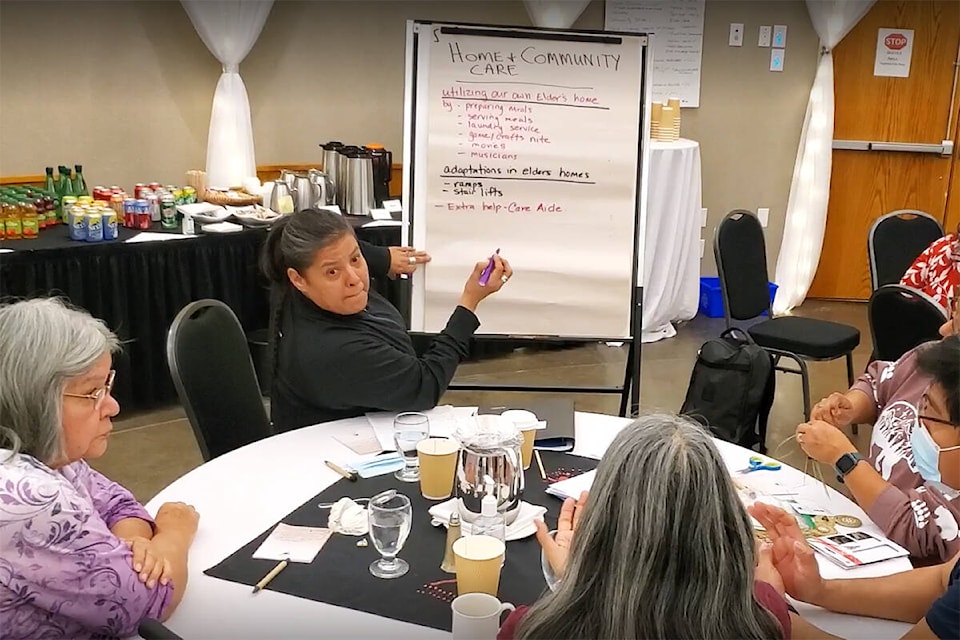The Simpcw First Nation’s Health Program has received recognition from Accreditation Canada for its health care standards.
The program was given the designation of accreditation with exemplary standing (99.8 per cent) on the Qmentum survey, following an assessment by Accreditation Canada, a non-profit organization that provides certificates to health care programs that meet certain standards on assessments.
Two peer surveyors visited the Simpcw Health Program to assess more than 600 care standards. The program only failed to meet one: the succession plan for the program’s leadership was not documented.
“We had to review a number of the standards to make sure what we surveyed was correct because we have never seen a community that had almost had a perfect score before,” said Keith Marshall, president of the First Nations Health Directors Association and one of the two surveyors.
He said before his assessment of the Simpcw Health Program, the highest score he had ever seen on the survey had missed three points.
Simpwc health director Shelley Lampreau, who has been in her role for roughly 11 years, said her approach to consultation boils down to ownership.
“Any time we do health planning, we do community consultation. We take all of the ideas and do strategic planning with our community,” Lampreau said. “You’re building programs for the people, so the people should be part of that development.”
This is not the first time Simpcw’s consultation process has been recognized. In 2021, the Rural Coordination Centre of British Columbia - a network of medical professionals, advocates and administrators that work to promote rural health equity through training and research - was so impressed with the work being done by Simpcw that it returned to film a short documentary about it.
The documentary was shown at a Towards Unity for Health international conference in Vancouver last year, where Lampreau also spoke about the program.
“It was inspiring to see true community consultation in action, rooted in consistency, autonomy and relationships. This inclusive approach has, no doubt, contributed to the many successes of Simpcw’s health programs and to the overall health of its community members,” project coordinator Krystal Wong said in a statement to the Star Journal.
Except for services that are mandatory province-wide, all of the Simpcw Health Program’s services are based on community planning sessions, where every member of the Simpcw First Nation can contribute.
The health program also does a needs assessment every five years.
Once the health program has input from the community at large, it does strategic planning with the Simpcw Health Board of Directors. The seven-person volunteer board is a relatively unique feature of the Simpcw Health Program. Marshall and his colleague also met with the board as part of the accreditation survey.
Once the Simpcw Health Program develops a complete strategic plan, it determines how it can best respond to the needs of the community.
“One of our top priorities is strengthening families,” Lampreau said. “We have put a lot of focus in the past couple of years on family activities, how we are supporting parenting and how we are supporting reconnecting with family members. We have done workshops, we have done retreats all based around family.”
When the community identifies a gap in services, Lampreau also tries to find resources beyond what the BC First Nations’ Health Authority — responsible for funding the Simpcw Health Program’s services — has already allocated to the program.
“I write a lot of proposals. If there is something we want, I find a funding stream and then we write proposals,” Lampreau said. “Whatever we need, I usually apply for.”
For example, the health program received a grant from the federal New Horizon’s for Seniors’ Program to develop new Elders’ services, such as nutrition and physical activities. Through that grant, the health program also hosted workshops on financial planning and Elders’ rights.
There was also a workshop on designing an advanced care plan, which tells health care professionals how a person would like to receive care if they are incapacitated by an ailment or injury.
Another grant funded the purchase of herbal medicines from a Secwepemc-owned Indigenous product company. The health program also administers on-the-land healing funding from the Secwepemc nation, she said. The Simpcw First Nation is a division of the Secwepemc nation, which is currently divided into 17 bands.
On-the-land healing is often administered by the Simpcw First Nation’s language and culture department, which hosts men’s and women’s hunting camps, fishing, berry-picking and other practices to help community members reconnect with the land, Lampreau said.
“That is to look at a more culturally appropriate way of dealing with trauma and healing,” Lampreau said.
Although Lampreau saw many successes at the health program in the past decade, some barriers such as housing access and other social health issues are an ongoing challenge. Lack of access to equitable services is amplified by the shortage of doctors in the province, Lampreau said.
The Simpcw Health Program works with the First Nations’ Health Authority and Interior Health Authority to address some of the gaps relating to essential care.
Through one program, six Secwepemc communities share a nurse practitioner who opens a clinic in the community one day per week. Nurse practitioners can help fill gaps left by a lack of family doctors by prescribing medications, order testing and referring patients to specialists.
“Partnerships are something that is very important. We have to continue to build our partnerships and work together to create a better system of care for our Indigenous population.”
